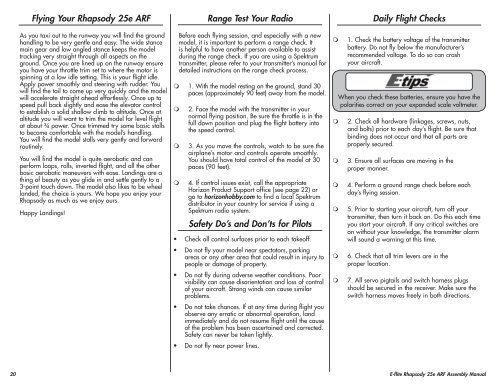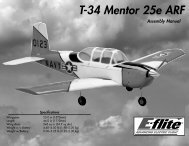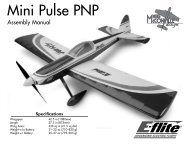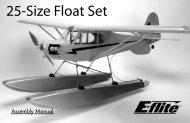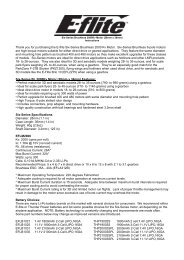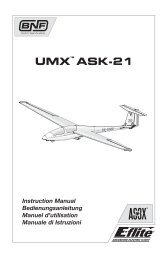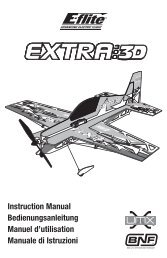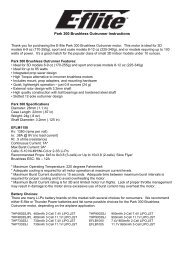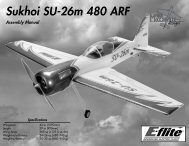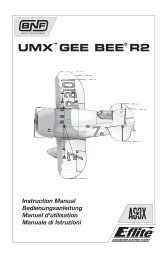You also want an ePaper? Increase the reach of your titles
YUMPU automatically turns print PDFs into web optimized ePapers that Google loves.
Flying Your <strong>Rhapsody</strong> <strong>25e</strong> <strong>ARF</strong><br />
As you taxi out to the runway you will find the ground<br />
handling to be very gentle and easy. The wide stance<br />
main gear and low angled stance keeps the model<br />
tracking very straight through all aspects on the<br />
ground. Once you are lined up on the runway ensure<br />
you have your throttle trim set to where the motor is<br />
spinning at a low idle setting. This is your flight idle.<br />
Apply power smoothly and steering with rudder. You<br />
will find the tail to come up very quickly and the model<br />
will accelerate straight ahead effortlessly. Once up to<br />
speed pull back slightly and ease the elevator control<br />
to establish a solid shallow climb to altitude. Once at<br />
altitude you will want to trim the model for level flight<br />
at about ¾ power. Once trimmed try some basic stalls<br />
to become comfortable with the model’s handling.<br />
You will find the model stalls very gently and forward<br />
routinely.<br />
You will find the model is quite aerobatic and can<br />
perform loops, rolls, inverted flight, and all the other<br />
basic aerobatic maneuvers with ease. Landings are a<br />
thing of beauty as you glide in and settle gently to a<br />
3-point touch down. The model also likes to be wheel<br />
landed, the choice is yours. We hope you enjoy your<br />
<strong>Rhapsody</strong> as much as we enjoy ours.<br />
Happy Landings!<br />
Range Test Your Radio<br />
Before each flying session, and especially with a new<br />
model, it is important to perform a range check. It<br />
is helpful to have another person available to assist<br />
during the range check. If you are using a Spektrum<br />
transmitter, please refer to your transmitter’s manual for<br />
detailed instructions on the range check process.<br />
1. With the model resting on the ground, stand 30<br />
paces (approximately 90 feet) away from the model.<br />
<br />
<br />
<br />
2. Face the model with the transmitter in your<br />
normal flying position. Be sure the throttle is in the<br />
full down position and plug the flight battery into<br />
the speed control.<br />
3. As you move the controls, watch to be sure the<br />
airplane’s motor and controls operate smoothly.<br />
You should have total control of the model at 30<br />
paces (90 feet).<br />
4. If control issues exist, call the appropriate<br />
Horizon Product Support office (see page 22) or<br />
go to horizonhobby.com to find a local Spektrum<br />
distributor in your country for service if using a<br />
Spektrum radio system.<br />
Safety Do’s and Don’ts for Pilots<br />
• Check all control surfaces prior to each takeoff.<br />
• Do not fly your model near spectators, parking<br />
areas or any other area that could result in injury to<br />
people or damage of property.<br />
• Do not fly during adverse weather conditions. Poor<br />
visibility can cause disorientation and loss of control<br />
of your aircraft. Strong winds can cause similar<br />
problems.<br />
• Do not take chances. If at any time during flight you<br />
observe any erratic or abnormal operation, land<br />
immediately and do not resume flight until the cause<br />
of the problem has been ascertained and corrected.<br />
Safety can never be taken lightly.<br />
• Do not fly near power lines.<br />
<br />
<br />
<br />
<br />
<br />
<br />
<br />
Daily Flight Checks<br />
1. Check the battery voltage of the transmitter<br />
battery. Do not fly below the manufacturer’s<br />
recommended voltage. To do so can crash<br />
your aircraft.<br />
When you check these batteries, ensure you have the<br />
polarities correct on your expanded scale voltmeter.<br />
2. Check all hardware (linkages, screws, nuts,<br />
and bolts) prior to each day’s flight. Be sure that<br />
binding does not occur and that all parts are<br />
properly secured.<br />
3. Ensure all surfaces are moving in the<br />
proper manner.<br />
4. Perform a ground range check before each<br />
day’s flying session.<br />
5. Prior to starting your aircraft, turn off your<br />
transmitter, then turn it back on. Do this each time<br />
you start your aircraft. If any critical switches are<br />
on without your knowledge, the transmitter alarm<br />
will sound a warning at this time.<br />
6. Check that all trim levers are in the<br />
proper location.<br />
7. All servo pigtails and switch harness plugs<br />
should be secured in the receiver. Make sure the<br />
switch harness moves freely in both directions.<br />
20 E-<strong>flite</strong> <strong>Rhapsody</strong> <strong>25e</strong> <strong>ARF</strong> Assembly Manual


